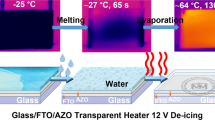Conclusions
In the spectra of oxide-coated glass S-279 in the ultraviolet and infrared regions there are peaks expressing the different kinds of oscillations of the fragments O-Si-O. The reflection spectra of resistive layers based on the solid solution Sn0.9Sb0.1O2 are analogous to the spectra of pure solid solution: this indicates segregation of the current-conducting phase on the surface of the films.
Similar content being viewed by others
Literature cited
A. I. Antonyan, M. D. Smolin, V. G. Grebenkina, et al., Variable Thick-Film Resistors [in Russian], Naukova Dumka, Kiev (1980).
D. E. Dyshel', B. M. Rud', V. P. Smirnov, and M. D. Smolin, “Effect of the structure on the electrical resistivity of thick films based on alloyed tin oxide,” Izv. Akad. Nauk SSSR, Neorg. Mater.,21, No. 10, 1706–1709 (1985).
D. E. Dyshel', B. M. Rud', M. D. Smolin, and I. A. Stoyanov, “The electrical conductivity of composite films based on alloyed tin dioxide at low-temperatures,” Dokl. Akad. Nauk UkrSSR, Ser. A, No. 2, 69–72 (1986).
D. E. Dyshel', B. M. Rud', and M. D. Smolin, “The nature of activation conductance in composite films based on powdered alloyed in dioxide and glass,” Poroshk. Metall., No. 11, 63–67 (1987).
L. A. Ivanchenko and V. A. Serdyuk, Application of the Methods of Absorption Spectroscopy for Studying High Melting Compouds and Materials Based on Them [in Russian], Preprint
G. Samoggia, M. Scagliotti, “Reflectivity of thick film (cermet) resistors,” Thin Solid Films,103, 322–331 (1983).
A. N. Lazarev, Oscillation Spectra and the Structure of Silicates [in Russian], Nauka, Leningrad (1968).
N. Mott and E. Davis, Electronic Processes in Noncrystalline Substances [Russian translation], Mir, Moscow (1982).
A. Felz, Amorphous and Vitreous Inorganic Solids [Russian translation], Mir, Soc.,A309,
V. A. Mashkov, “Calculation of dielectric permeability of lead-silicate glasses,” Fiz. Khim. Stekla,10, No. 2, 163–173 (1984).
R. M. Hill, “Electrical conduction in ultra thin metal films” Proc. R., Soc.,A309, No. 1498, 377–417 (1969).
R. M. Hill, “Electrical conduction in discontinuous metal films” Contemp. Phys.,10, No. 3, 221–240 (1969).
E. Shanthi, V. Dutta, A. Banerjee, and K. Chopra, “Electrical and optical properties of undoped and antimony-doped tin oxide films,” J. Appl. Phys.,51, No. 12, 6243–6251 (1980).
K. Kobayashi, I. Aikawa, and M. Sukigara, “Tunnel electrode I. Electron transfer process at highly doped SnO2 electrode with Ce4+ in high over-voltage region,” Bull. Chem. Soc. Jpn.,55, No. 9. 2820–2826 (1982).
Author information
Authors and Affiliations
Additional information
Translated from Poroshkovaya Metallurgiya, No. 1(325), pp. 82–85, January, 1990.
Rights and permissions
About this article
Cite this article
Dyshel', D.E., Ivanchenko, L.A. Reflection spectra of resistive composites based on powdered alloyed tin dioxide and glass. Powder Metall Met Ceram 29, 75–77 (1990). https://doi.org/10.1007/BF00796101
Received:
Issue Date:
DOI: https://doi.org/10.1007/BF00796101




